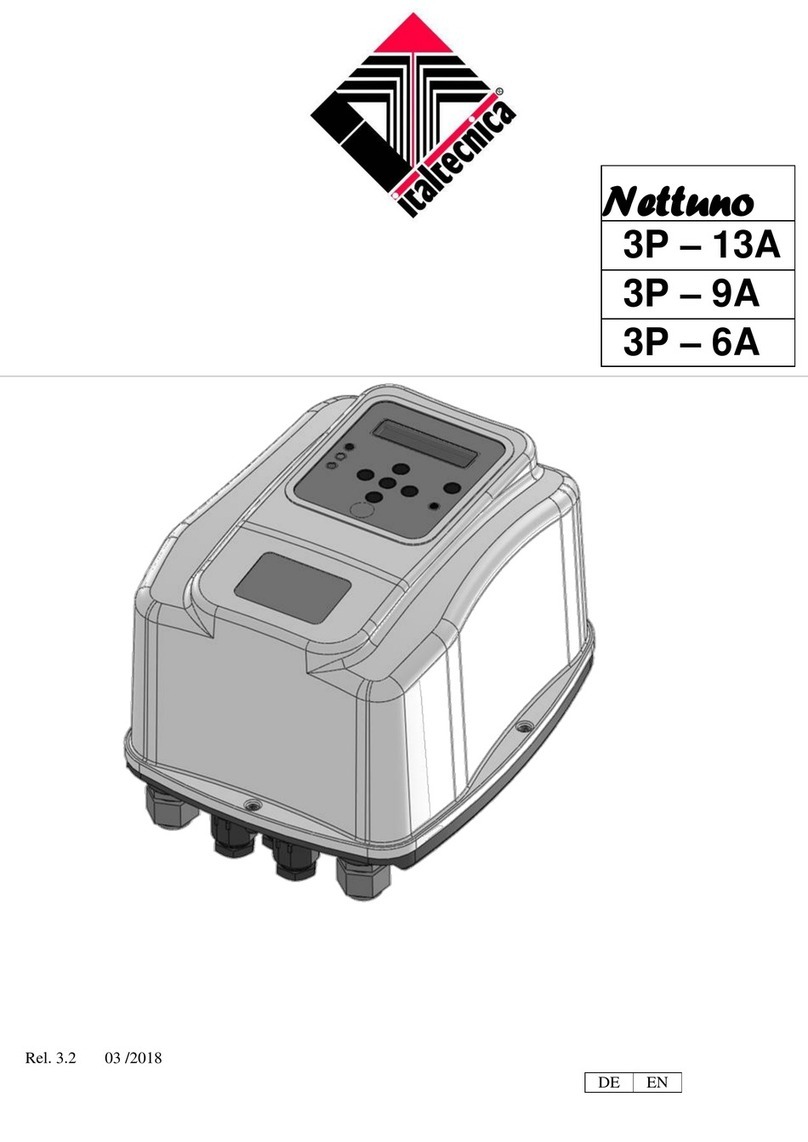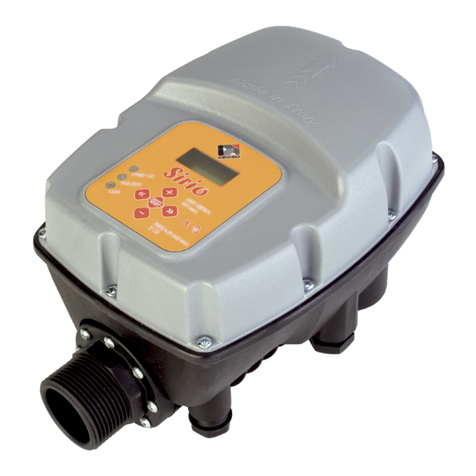
Frequenza minima: questo parametro definisce la frequenza minima alla quale la pompa viene avviata e
fermata. Per pompe trifase si suggerisce il valore di 25Hz, per pompe monofase 30Hz.
Consultare anche le informazioni fornite dal costruttore dell’elettropompa per determinare a quale valore di
frequenza minima può funzionare il motore elettrico collegato.
Frequenza di stop: solo nel funzionamento senza flussostato, questo parametro determina il valore di
frequenza minima al disotto del quale il motore viene fermato. Durante la regolazione, se viene raggiunto il
valore di pressione di Pmax e la frequenza del motore è inferiore a questo valore l’inverter esegue un tentativo
di fermata del motore. Se tutti gli utilizzi sono chiusi e la pressione rimane costante la pompa viene
correttamente fermata. Qualora la pompa non si fermi, provare ad incrementare questo valore. Al contrario, se
la pompa esegue dei continui cicli di accensione e spegnimento, provare a diminuire il valore della frequenza di stop.
Frequenza nominale motore: in base al motore impiegato è possibile selezionare la frequenza massima
nominale in uscita dall’inverter (50 o 60 Hz). Attenzione: una selezione errata della frequenza massima può
causare il danneggiamento della pompa, consultare con attenzione i dati tecnici forniti dal costruttore.
Frequenza di switching: imposta la frequenza di switching dell’inverter. I valori selezionabili sono 3, 5 e 10
kHz. Valori più alti della frequenza di switching possono ridurre la rumorosità dell’inverter e consentire una
regolazione più fluida del motore ma potrebbero causare un maggiore riscaldamento della scheda elettronica,
un incremento dei disturbi elettromagnetici e potenziali danni al motore elettrico (specialmente con cavi molto
lunghi). Valori bassi di frequenza di switching sono raccomandati per pompe di dimensioni medio-grandi, nel
caso di lunghe ditanze tra inverter e motore ed in caso di temperature ambiente elevate.
Correzione frequenza: con questo parametro è possibile impostare uno scostamento, positivo o negativo,
della frequenza massima rispetto al valore nominale programmato. Può essere utile impostare uno scostamento
negativo (fino a –5Hz) quando si intende limitare la potenza massima dell’elettropompa ed evitare possibili
condizioni di sovraccarico. L’incremento positivo (fino a +5Hz) può essere invece necessario quando vengono
richieste prestazioni leggermente superiori all’elettropompa. Mente non esistono particolari precauzioni nel
diminuire la frequenza massima, il suo incremento deve essere attentamente valutato dopo aver consultato il parere del costruttore
dell’elettropompa e tenedo in considerazione la corrente massima sopportata dall’inverter stesso.
Soft-Start (avvio progressivo): Da questa schermata è possibile attivare o disattivare la funzione di “soft
start”. Quando questa funzione è attiva la pompa viene avviata progressivamente;in caso contrario viene
avviata sempre al massimo dei giri per un tempo di 1 secondo prima di iniziare la regolazione del numero di
giri.
Tipo pompa: consente di specificare se la pompa collegata è di tipo monofase con condensatore di avviamento
(1 X 230V) oppure trifase con collegamento a triangolo (3 X 230V).
Sensore di flusso: abilita o disabilita il funzionamento del flussostato integrato. L’impostazione di fabbrica
prevede che il flussostato sia attivato, in modo tale che la pompa venga fermata alla chiusura dei rubinetti
rilevando l’azzeramento del flusso attraverso l’inverter. Lo stesso principio viene utilizzato per la protezione
contro la marcia a secco. Tuttavia si possono verificare condizioni (ad esempio l’uso con acqua non
perfettamente pulita) che possono interferire con il buon funzionamento del flussostato, impedendo il corretto
arresto della pompa. In queste condizioni è possibile disattivare il flussostato e far funzionare il Sirio unicamente tramite le informazioni di
pressione e frequenza. In questo caso è indispensabile regolare correttamente i parametri di frequenza di stop e di pressione di marcia a secco
per un corretto funzionamento dell’inverter. Inoltre, quando il flussostato viene disattivato, è obbligatorio installare un vaso di espansione
dopo il Sirio per aiutare la regolazione della pressione nella fase di spegnimento ed evitare riavvii continui della pompa, avendo cura di
verificarne periodicamente il valore di precarica.
Origine comando: seleziona la sorgente di comando. Impostando il parametro su pressione, il funzionamento
è regolato in maniera automatica in base alla pressione nell’impianto. Selezionando la modalità manuale è
invece possibile comandare manualmente l’avvio, l’arresto e la velocità dell’elettropompa direttamente dalla
tastiera. Attenzione: in modalità manuale non sono attive le protezioni di marcia a secco e di limitazione della
pressione. Questa modalità deve essere usata solo temporaneamente e sotto il diretto controllo di una persona.
Prestare la massima attenzione!






























